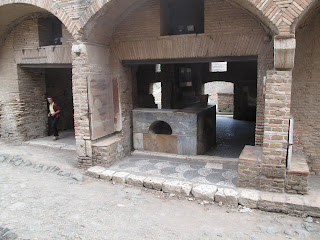The next day we set out for Ostia Antica,
ancient Ostia. Although I had studied Ostia
in classes and written about it in my book, Ancient
Cities, this was my first visit and I was very much looking forward to
it.
Located at the mouth of the Tiber, Ostia was
Rome’s port, thriving in particular in the 2nd century AD, when the emperor
Trajan expanded the nearby harbor facilities, but falling in decline from the 3rd
century on. Since it wasn’t much built
over in the Middle Ages and later, archaeologists have had good access to the ruins.
Much was cleared in the 19th and early 20th
centuries, in the grand manner of yesteryear: big sections of buildings emptied
of earth by many workmen, without much attention paid to the niceties of
stratigraphy. In addition, much
consolidation and restoration has been done, although details of when and how are
rarely made clear.
To get to Ostia
we had to take a train – a 30-minute walk from our hotel. We followed the Tiber on a wide tree-lined
sidewalk, enjoying the view of the river
and taking a look at the “Ponte Rotto”
(the “Broken Bridge,” a fragment of the Pons Aemilius, the oldest stone bridge
in Rome, built in the 2nd century BC).
To our left was the Aventine Hill, one of
Rome’s classic seven hills. High above
us, atop a large complex, a flag with the Maltese cross was flying, the
insignia of the Sovereign Order of Malta, a venerable member of the many Catholic
religious establishments in this city.
Magistral Villa / Villa del Priorato di Malta [belongs to the Sovereign Order of Malta)(Photo
credit: By Lalupa - Own work, CC BY-SA 3.0, https://commons.wikimedia.org/w/index.php?curid=2929050)
At the south end
of the Aventine we left the river and turned inland on the Via Marmorata. We passed in front of a Post Office built in 1935,
a striking example of the architecture of the Mussolini period – very different
from the Renaissance and Baroque architecture that marks the city center.
Palazzo delle Poste Roma Ostiense. Architect: Adalberto Libera. 1935
Soon after we
reached the large square with our station.
Also here are the Porta San Paolo, an impressive gate into the late 3rd
century AD city walls (the Aurelian walls, so-called after the emperor Aurelius,
who had them built)
Porta San Paolo (Saint Paul Gate)
and a pyramid, the tomb of Gaius Cestius, a wealthy Roman
who decided an imitation of an Egyptian tomb would be just the thing (12
BC).
Beyond the pyramid lies the Protestant
Cemetery, something unusual in this Catholic city. Buried here are such notables as the poets
Keats and Shelley.
Our train was
heading to the beach, the Lido of Ostia, and many passengers were dressed with
beach in mind. After a 30-minute ride,
we got off and walked to the site.
It’s
vast, and now attractively filled with umbrella pines, the signature tree of
Rome, as well as the extensive remains of buildings, almost all of orange-red
baked bricks.
It’s also on the flight
path to Rome’s biggest airport, Fiumicino, located just across the Tiber on the
site of the ancient imperial harbors, so above us, airplanes were heading in
with frequent regularity.
We had lunch at
the on-site restaurant, visited the small museum (filled with Roman sculpture
but nothing about the history and architecture of the city), and walked around
the site, a visit that took several hours.
There weren’t masses of tourists, even if we were never alone for long,
and it wasn’t too hot.
In some buildings, no doubt restored, you
could climb up to an upper story and get a good view.
Elsewhere, we wandered inside buildings with
many rooms and courts, all this giving a good sense of the complexity of Roman
architecture and city life.
A highlight: the Portico of the Corporations (Piazzale delle Corporazioni) located behind the small theater.
The
portico framed a large garden with a small temple. Behind the portico lay the offices of
companies involved in maritime shipping.
In front of many of these offices was a floor mosaic, black and white,
with images and inscriptions indicating the company’s specialty.
An elephant, a sign of traders from Sabratha
(in today’s Libya), is a favorite,
but there are other mosaics of equal
interest.
Another highlight: the House of Cupid (Amor)
and Psyche, a late (4th century AD) house, clearly belonging to wealthy people,
finely decorated with beautiful marble.
It is located at the far end of the site, but worth the effort to find.
After we left the ruins, I went into the
ticket office / bookstore and bought a good guidebook to the site. I wish I had had it with me as we walked
around. The explanatory panels are difficult
to follow, and the maps posted do not indicate clearly where you are.
We took the train back to Rome, then walked
back to the hotel, stopping on the way in the ancient Forum Boarium (cattle
market), just in from the Tiber, to admire the two well-preserved temples, one
round (Temple of Hercules Victor),
the other rectangular (Temple of
Portunus).
No one else was inspecting
them, but across the street we noticed a long line. What were these people waiting for? To take their turn to enter the portico of
the Church of Santa Maria in Cosmedin, to see “La Bocca della Verità”
(“The mouth of truth”), an ancient sculpture, round in shape, of a bearded man
with his mouth open.
According to the
legend, if you put your hand inside and swear falsely, the mouth will close and
cut off the hand. Audrey Hepburn and
Gregory Peck were here in “Roman Holiday” (1953) – a long time ago, but how can
we forget them?
After the temples, one additional stop:
ice cream!






















No comments:
Post a Comment